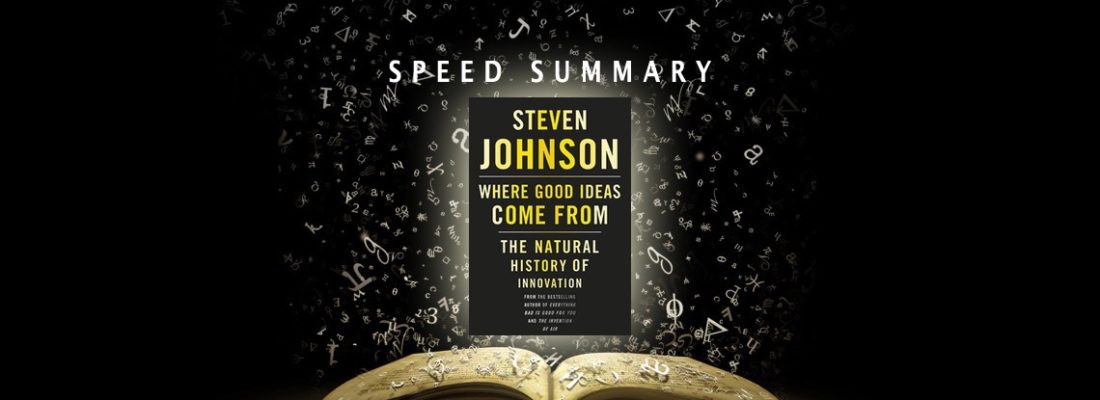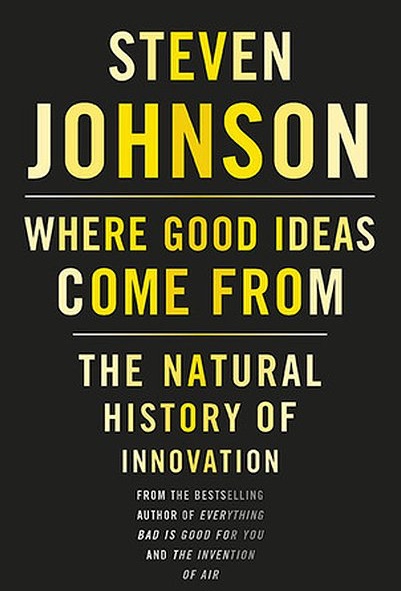Speed Summary: Where Good Ideas Come From – The Natural History of Innovation


- Where Good Ideas Come From – The Natural History of Innovation
- Author: Steven Johnson
- Publisher: Allan Lane
- Publication: 2010
Where do good innovation ideas come from?
The short answer; coffee houses.
Longer answer, from the seven places listed below.
From a review of 189 great ideas from pencils to parachutes, best-selling business and popular science author Steven Johnson traces the history of successful innovations to identify where good ideas come from – and where they don’t.
First, where good ideas don’t come from.
Good ideas do not – for the most part – come from inside someone’s head. Instead, they come from outside – specifically from social interaction. A study conducted in leading research laboratories found that scientists rarely, if ever, had a flash of inspiration or eureka moment alone in the lab. Instead, ideas happen in conversation with colleagues. So want a great idea? Then go to a coffee house and talk with someone.
So want a great idea? Then go to a coffee house and talk with someone.
Nor do good ideas come from thoughts or visions. Instead, they come from stuff. Every great idea is a combination or mutation of an idea that has already been brought to life. Ideas brought to life in products that are already out there are the building blocks of innovation – not thoughts.
Finally, good ideas do not come from looking forward or back, rather they come from looking left and right, to what is adjacent to us. Johnson builds on Stuart Kauffman’s concept of the ‘adjacent possible’ to reaffirm that tomorrow’s great innovations are built from the stuff of today – specifically from the things around us that can be combined into something new.
“The strange and beautiful truth about the adjacent possible is that its boundaries grow as you explore them. Each new combination opens up the possibility of other new combinations”.
Seven Questions for Finding Good Ideas
Based on a review of good ideas brought to life as innovations, Johnson suggests that there are seven specific places to look where you’ll find the seeds of a great idea. Importantly, they’ll not be found where you are right now. Changing up your environment, and exposing yourself to new ideas is key. But one in a new space, the ‘places’ where your good ideas will come from are seven principles that can be formulated as seven questions to ask yourself – and your colleagues.
- What new possibilities are there today, that didn’t exist a year ago? (principle of adjacent possibilities)
- What hunches have you had for some time about what to do)? (principle of slow hunches – the more others share them or build on them, the better they may be)
- What do fresh eyes think we should do (principle of liquid networks)
- What’s worked that’s surprised us? (principle of serendipity – build on what surprises, chance happenings)
- What’s the biggest learning from our biggest error? (principle of error)
- What other purpose can our product or service be used for? (principle of exaptation – bird feather evolved for warmth, and then through ‘exaptation’ they became wings)
- What big success can we build on? (platform principle)
For us as individuals, Johnson summarises his insights for how we can increase the chances we’ll participate in evolving good innovation ideas
“The patterns are simple, but followed together, they make for a whole that is wiser than the sum of its parts. Go for a walk; cultivate hunches; write everything down, but keep your folders messy; embrace serendipity; make generative mistakes; take on multiple hobbies; frequent coffeehouses and other liquid networks; follow the links; let others build on your ideas; borrow, recycle, re-invent.”
The Brand Genetics Take
With a name like Brand Genetics, we’re predisposed to the central idea that ideas are never ‘created’ out of nothing, but are creative combinations and mutations of existing ideas that have already been brought to life. The principle of exaptation (finding new uses for existing things) is underused and potentially powerful in innovation. As is the notion of the adjacent possible; don’t look forward, backwards or inwards – but instead outwards to our left and right seems sound advice. Sometimes we can be blinkered by a vision or a goal, and fail to see opportunities lying next to us.




